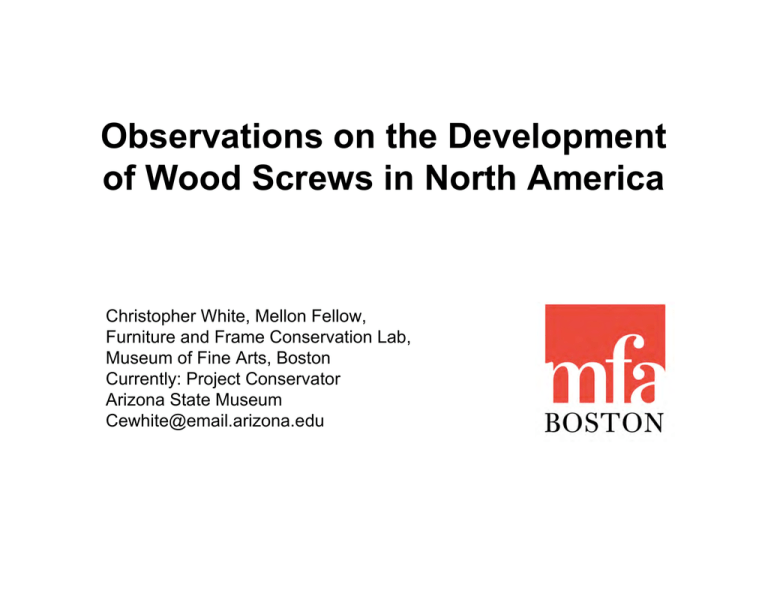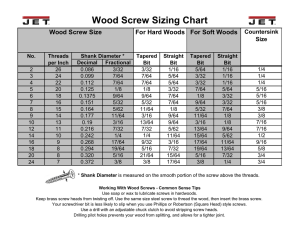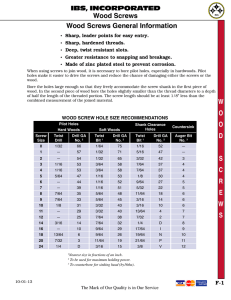Observations on the Development of Wood Screws in North America
advertisement

Observations on the Development of Wood Screws in North America Christopher White, Mellon Fellow, Furniture and Frame Conservation Lab, Museum of Fine Arts, Boston Currently: Project Conservator Arizona State Museum Cewhite@email.arizona.edu INTRODUCTION The following is the result of research conducted between September 2004 and August 2005 at the Museum of Fine Arts, Boston. Physical characteristics of a series of wood screws from the museum’s collection of 18th and 19th-century American furniture are summarized and their characteristics related to curatorial-assigned dates of fabrication and to a chronology of screw manufacturing techniques. The documentation forms a survey of the development of the wood screw in 18th and 19thcentury American furniture. While there are surely exceptions to this outline, it may serve as a starting point for a more comprehensive study of development of the wood screw in America. Wood screws are a frequent component of furniture since the mid 18th century. The development of wood screws since then has provided furniture conservators with a unique diagnostic aid in understanding furniture. An outline of wood screw history will be combined with examples of wood screws from furniture in the Museum of Fine Arts’ collection. HISTORY • The use of metal screws as fasteners began in Europe in the 15th century. The screw was used in furniture but did not become a common woodworking fastener until efficient machine tools were developed near the end of the 18th century. The earliest record of lathe made wood screws dates to an English patent of 1760. • The development of wood screws progressed from a small cottage industry in the late 18th century to a highly mechanized industry by the mid-19th century. This rapid transformation is marked by several technical innovations that help identify the time that a screw was produced. • The earliest, handmade wood screws were made from hand-forged blanks. These screws were originally produced in homes and shops in and around the manufacturing centers of 18th century Europe. Individuals, families or small groups participated in the production of screw blanks and the cutting of the threads. These small operations produced screws individually, using a series of files, chisels and cutting tools to form the threads and slot the head. Screws produced by this technique can vary significantly in their shape and the thread pitch. They are most easily identified by the profusion of file marks (in many directions) over the surface. • The first record regarding the industrial manufacture of wood screws is an English patent registered to Job and William Wyatt of Staffordshire in 1760. Their patent outlined the use of a lathe and a set of metal cutting tools which were repeatedly run over the shank of the screw blank to cut threads, which facilitated hand production. The lathe used a type of inline guide screw fitted to one end of the lathe, which was often referred to as a tail screw. The tail screw was manually engaged by the operator so that the entire spindle advanced at the pitch of the tail screw. The threads were cut into the blank as it advanced by forcing a cutting tool against the surface. This process was repeated until satisfactory threads were formed. • • • • Screws from this type of lathe were made from both hand-forged blanks and, later, drawn wire (note screw from wine cooler, ca.1795). Screws using wire stock are easily identified by the longitudinal scratches that remain as part of the wire-forming process. Hand forged blanks often retain small facets formed by hammering and irregular cross section. The threads usually have significant variations in their form. The threads of some screws tapered across the length of the shank, producing a screw with poor holding strength. Often the crests of these screws were flat and show a slight burr of metal where the thread cutting tool has deformed rather than removed the upper surface. Later threading tools operated at higher speeds and usually removed metal without creating excessive burrs. The troughs of lathe made screws acquire a smooth rounded shape that has not been adequately explained. It seems likely that rounded troughs are a product of a manufacturing process that used low speed wood-frame lathes and inferior cutting steel. The earliest examples of rounded thread troughs encountered during this study date from ca.1795 and disappear between 1830 and 1840, at which time the troughs become more square. This change likely correlates to the faster, stronger all-steel lathes and hardened cutting tools that were introduced during this period. The heads of screws retain a hand finished appearance until about 1837 when a patent was filed for a machine to automatically finish screw heads as they spun, producing a distinctive circular pattern on the upper and lower surfaces of the head. The earliest example encountered in this study of a definitively machine-finished head dates from ca.1845. The development of the gimlet point ( a threaded cone point usually having a point angle of 45-50 degrees) has been attributed to the 1837 U.S. Patent 154 filed by inventors Sloat and Springsteen. A mid-19th century source attributes the first gimletpointed wood screws to the Providence Screw Company in 1834. A historian of technology writing in 1941 attributes the first gimlet-pointed wood screws to Cullen Whipple at the New England Screw Company in 1849. The earliest example in this study dates from ca.1845. Illustration of an early screw threading machine, Henry Crum, U.S. Patent number 79, 1836. This design remained very similar to the 1760 English Patent of Job and William Wyatt. Illustration of a screw heading machine, Jeremiah Pierson, U.S. Patent number 86, 1836. This was an improvement over the older process of hand-heading that required a heated blank to be hammered to form the flare of the head. Thomas Harvey’s U.S. Patent 148, granted in 1837 is the first to specify the finishing of screw heads while rotating. This innovation produced a screw head with circular machining marks on the surface rather than linear file marks on the heads and fine, faceted file marks on the flanks of the head. Note 1977.955, ca.1840. Portion of the illustration for Thomas Sloan’s 1846 U.S. Patent owned by the Eagle Screw Company for making gimlet point wood screws. Portion of the illustration for the 1858 Patent for improvements on making gimlet point wood screws using a single cutting tool. Bombe chest of drawers, Boston, MA, about 1780 Screw removed from handle. Ca.1780 – Screw appears to be completely hand-made. There are numerous file marks defining the threads, the shank and the head of the screw. The troughs of the threads are defined by numerous small file marks and an angular square profile; this is a characteristic of threads manufactured by hand. It was likely made from a forged blank. Note that the maker formed a simple gimlet point by tapering the point and threads. Wine cooler, John Seymour, about 1795 Screw removed from caster. Ca.1795 – The screw appears to be formed from drawn wire (note the faint longitudinal scratches on the shank). The trough is a very smooth turned surface, indicating that some type of lathe was used to form the threads. The head of the screw retains linear file marks and a slightly off-center slot, indicative of hand finishing. Note the constant taper of the threads; this may be an example illustrating an early disadvantage of lathe screw production that imitated gimlet points. The constant taper of the threads produced a screw that did not securely engage the wood. Chest of drawers, about 1810 Screw removed from lock. Ca.1810 - A lathe-produced blunt wood screw without any thread or profile taper. The distinctive longitudinal scratches of drawn wire are easily identified on this screw shank. Linear file marks on the head indicate hand finishing for this portion of production. Dressing bureau, Holmes and Haines, 1825-1929 Screw removed from lock. 1825-1829 Similar to the example above. Note that the slot and shape of the head are more regular than the ca.1795 and ca.1810 examples. Several U.S. patents record machines for the nicking and heading of screws in 1814 and 1815; it is unclear what these advances were or if they are relevant to the slight changes here. These patents were lost in the “Great Patent Fire” of 1936. Desk and bookcase, Anthony G. Quervelle, about 1830 Removable screw used to join upper and lower case. Ca.1830 - This example shows a tapering core profile in which the threads are gradually cut into the shank, providing additional strength to what had been an area of frequent failure. The head retains linear file marks and there are file marks on the upper shank indicating some hand finishing continued. Door of Roswell Gleason House Parlor, about 1840 Screw removed from hardware. Ca.1840 - Although the upper surface of this screw head has been obscured by corrosion, the lower surface retains the circular machine marks indicating that the head of this screw was machine-formed and may correspond to U.S. Patent 148 in 1837 that introduced a cutting mechanism to form screw heads as they rotated. The threads also begin to acquire a square rather than a rounded profile, characteristic of screws from ca.1795-1830. It is unclear if the profile of thread troughs is significant to the development of wood screws. Side chair, 1840-1850 Screw removed from caster. Ca.1845 – This example illustrates the gimlet point wood screw, virtually indistinguishable from modern types. The screw has an angular thread profile similar to modern ASTM standards. The thread crests often have a flat surface rather than a sharp or burred edge as seen in the ca.1830 and ca.1840 examples. There is little or no taper of the core profile until the first or second thread before the gimlet point. METHODOLOGY • The removal of wood screws from furniture is an invasive procedure and should not be undertaken without curatorial consultation. The wood screws documented during this project were only removed in order to access brass hardware for alloy analysis. • All hardware and screws were documented before removal and after replacement using digital photography. Hardware and screws were scanned at 1200dpi on an Epson 1250s flatbed scanner and saved as uncompressed JPG files. Hardware was removed using hand filed screwdrivers matching exactly the size of the head slot. Dates assigned to objects are taken from the Museum of Fine Arts curatorial records and object files. THANKS TO • The Mellon Foundation • The Museum of Fine Arts, Boston: Gordon Hanlon, Gerry Ward, Angela Meincke, Caleb Hammond, and James Cain Bibliography: The History of the Wood Screw ANSI. 1997. American National Standards Committee B18 Standardization of Bolts, Nuts, Rivets, Screws Washers and Similar Fasteners.B18.6.1-1981, Reaffirmed 1997. New York: American Society of Mechanical Engineers. American Screw Company. http://www.artinruins.com/arch/historical/americanscrew/ Bennett, M. 1988. Development of the Machine-Made Wood Screw in England 1760-1860. Conservation News 35 (March) pp. 22-25. Bennett, M. 1995. Discovering and Restoring Antique Furniture. London: Cassell. Brooks, R. C. 1990. Origins, Usage and Production of Screws: An Historical Perspective. History and Technology. Vol. 8 pp. 51-76. Chamberlain, J. 1866. Manufacture of Iron Wood Screws. The Resources, Products and Industrial History of Birmingham and the Midland Hardware District. Ed. Samuel Timmins. London: Robert Hardwicke. Conley, P.T. and P. Campbell. 1982. Providence A Pictorial History. Norfolk/Virginia Beach: Donning Company, Publishers. Dickinson H. W. 1941. Origin and Manufacture of Wood Screws. Transaction of the Newcomer Society 22(80). Dobyns, K. W. 1997. A history of the Early Patent Offices: The Patent Office Pony. Fredericksburg, VA: Sergeant Kirkland’s Museum and Historical Society. Ferguson, E. S. ed. 1965. Early Engineering Reminiscences, 1815-1840, of George Escol Sellers. Washington D.C.: Smithsonian Institution. Gouldbeck, P. E. No Date. Methods of Examination. “The Conservator as Detective.” Some Notes on Fastenings. St. Louis: sine nomine. Harvey, Hayward A. (1824-1893) – American inventor. http://freepages.history.rootsweb.com/~dav4is/people/HALS623.htm Holtzapffel, C. 1846. Turning and Mechanical Manipulation. Intended as a Work of General Reference and Practical Instruction, on the Lathe, and the Various Mechanical Pursuits Followed by Amateurs. London. Kebabian, P. 1994. Thomas Harvey and the Manufacture of Wood Screws. The Chronicle of the Early American Industries Association. September, 47(3):84-87. Lardner, Rev. D. 1831-34. Cabinet Cyclopedia: A treatise on the progressive improvement & present state of the manufactures in metal. London : Printed for Longman, Rees, Orme, Brown, & Green. Mac Kenzie, R. V. 1961. Screw Threads: Design, Selection, and Specification. New York: Industrial Press. Mercer, H. C. 2000. Ancient Carpenters’ Tools. Dover Publications: Minneola, New York. Roberts, W. E. 1978. Wood Screws as an Aid to Dating Wooden Artifacts. The Chronicle of the Early American Industries Association. 31(1):14-16. Screw Threads. 1993. McGraw-Hill Encyclopedia of Engineering. New York: McGraw-Hill. Taylor, F. 2001. Learning About Screws. Professional Refinishing. February:18-19. United States. Patent Office. 1976. Subject-matter index of patents for inventions issued by the United States Patent Office from 1790 to 1873, Inclusive. New York: Arno Press. U.S. Patent Numbers X220 / X6441 / X9398 / 79 / 86 / 92 / 148 / 149 / 154 / 516 / Re2 / 830 / 1411 / 2161 / 2754 / 3029 / 4106 / 4548 / 4613 / 4704 / 4738 / 4864 / re88 / 5794 / re109 / re110 / 7748 / 7801 / re165 / 8379 / 9105 / 9223 / 9477 / 9688 / 11974 / 14041 / 15052 / re37116778 / re641 / 21641 / 23568 / re826 / 35406 / 42766 / 42767 / 42768 / 72490 / 78212 / re5472 / re7573 / re7574 Watts, Simon. 1982. Period Furniture Hardware. Fine Woodworking. 34 (May-June):86-91. White, Frank G. 1991. The Upturning of a Screw Manufactory. The Chronicle of the Early American Industries Association. 44(3):77-78. Wood, Richard. 1988. A Wood Screw Advertisement. The Chronicle of the Early American Industries Association. 41(3):50. Wright, Paul. No Date. Held by a Thread: A Brief History of Screws and Screwdrivers. Woodside, Sheffield: Stanley Works. David Williams Company. 1903. Iron Age Directory; A Classified Index of Goods Manufactured by Advertisers in the Iron Age. New York, David Williams Company.





